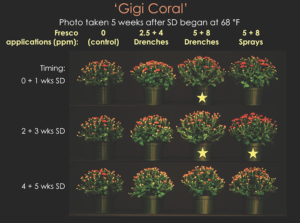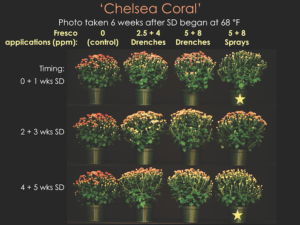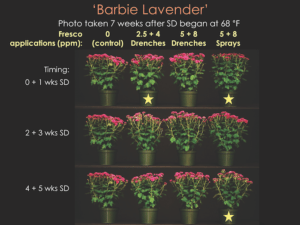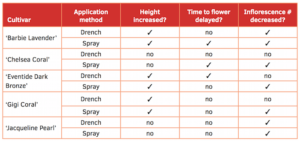Increasing Height of Chrysanthemum with PGR Drenches
Growing plants to a target height is a constant challenge. Often growers need to suppress stem elongation to reduce finished plant height; however, in some situations, they need to increase the height of their crop. This can be necessary if growth retardants are over-applied, or if environmental conditions have caused the plants to be too short.
During production of fall garden chrysanthemums, it is not uncommon for plants to become induced to flower too early. While chrysanthemums respond strongly to photoperiod, temperature also influences flower induction. If temperatures during the summer are relatively cool, especially at night, some mum varieties will form flower buds even if photoperiods are long. Since stem elongation slows dramatically once flowers begin to form, plants can be shorter at flower than desired.

One technique to increase stem length is to make an application of a product that contains gibberellic acid (GA). Several products that contain GA (with or without benzyladenine, BA) are registered for use on floriculture crops, including Fresco from Fine Americas. Fresco contains 1.8 percent GA 4+7 + 1.8 percent 6-BA.
We have conflicting information about the efficacy of GA when applied as a substrate drench. Traditionally it’s been thought that GA is only effective when applied to the plant shoots. However, some growers have reported positive responses when GA is applied as a drench by repeated foliar sprays delivered from booms, or when applied directly to the media, without contact with the foliage. Drench applications could also be useful on other potted flowering crops such as poinsettia, as well as on bedding plants, potentially offering a uniform plant response without negative effects on flowering.
Our objective was to determine the efficacy of Fresco as a substrate drench to increase height of garden chrysanthemum, and compare its effectiveness to that of spray applications.

Experimental Control
We obtained well-rooted chrysanthemum liners of ‘Barbie Lavender’, ‘Chelsea Coral’, ‘Eventide Dark Bronze’, ‘Gigi Coral’ and ‘Jacqueline Pearl’ from C. Raker & Sons on July 21, 2016. Liners were transplanted into 5-inch pots filled with a standard peat and perlite medium on July 27. On Aug. 1, all were pinched. Plants were irrigated as necessary with reverse osmosis water supplemented with a water-soluble fertilizer containing (ppm) 125 nitrogen, 12 phosphorus, 100 potassium, and other macro- and micro-nutrients (MSU RO Water Special; GreenCare Fertilizers, Inc.).
Plants were maintained at a constant 68° F, with a 16-hour long day and supplemental lighting from high-pressure sodium lamps. On Aug. 30, we initiated nine-hour short days (SD) by pulling blackout cloth at 5 p.m. and opening it at 8 a.m. daily.

Ten plants were assigned to each treatment, and we planned to give plants a single application at three different times: when SD began, after two weeks of SD or after four weeks of SD. We observed little response after the first treatment, so we modified the initial protocol, adding applications at higher rates to be made one week after each initial treatment. Thus, all treated plants received two applications one week apart:
Application rates and methods:
- None (control)
- 2.5-ppm drench (at zero, two or four weeks after start of SD) followed by 4.0-ppm drench one week later
- 5.0-ppm drench (at zero, two or four weeks after start of SD) followed by 8.0-ppm drench one week later
- 5.0-ppm spray (at zero, two or four weeks after start of SD) followed by 8.0-ppm spray one week later
Overhead drenches were made so the solution did not contact the foliage, but the growing medium was saturated, and the solution reached the bottom of the pot. The surfactant CapSil was added to all spray treatments. The spray was a heavy application (3 quarts/100 ft2) so the product was applied to initial runoff.
After SD began, heights were measured every week until the first flower opened on each plant. On that date, we recorded plant height and number of flower buds (inflorescences) showing color. We also calculated the height increase over the initial height of each plant.

Results
Plant height. Fresco applications increased height of ‘Barbie Lavender’, ‘Eventide Dark Bronze’ and ‘Gigi Coral’; treated plants were 1-1.5 inches taller at first flower than untreated plants (Figure 1). Sprays and drenches were similarly effective when applied at the same rate. We observed slightly more stem elongation with the higher rate of drench compared to the lower rate. Treatments were most effective when applied within three weeks of starting SD. Height of ‘Chelsey Coral’ and ‘Jacqueline Pearl’ was not affected by the treatments.
Time to flower. ‘Gigi Coral’ and ‘Jacqueline Pearl’ began flowering after about five weeks of SD while the other varieties started flowering after six to seven weeks. Time to first flower was delayed by one to five days in ‘Barbie Lavender’ and ‘Chelsea Coral’ plants that received the earliest or the latest spray treatments (Figure 2). Drenches influenced time to flower in only one instance: there was a slight (two day) delay in flowering of ‘Eventide Dark Bronze’ treated with 5+8 ppm drenches at two and three weeks after the start of SD.
Inflorescence number. Flower bud numbers were variable, and reduced by some treatments, but all plants were attractive and suitable for market. The earliest spray treatments resulted in fewer inflorescences on every cultivar (Figure 3). ‘Barbie Lavender’ and ‘Jacqueline Pearl’ plants treated with the earliest drench treatments also had fewer inflorescences than untreated plants.

Conclusions
Our results confirm that Fresco drenches, applied without contact to the foliage, can increase stem elongation in at least some varieties of garden mums (Table 1). Drenches offer potential advantages compared to spray applications such as reduced likelihood of a delay in flowering, and more visible flower buds when the first flower opens.
During this trial, we noticed another possible disadvantage to sprays: plants exhibited a very slight, temporary foliar chlorosis. To see how plants would respond to an excessively high rate, we treated some with a 50 ppm spray (Figure 4). As expected, both elongation and chlorosis were increased. Generally, though, the chlorosis was transient and didn’t negatively affect plant marketability.
For the best response, we suggest applying at least 5 ppm of Fresco within three weeks of starting SD. Plant responses are generally visible within a week, and if more elongation is desired, another application can be made. Our rates resulted in height increases of 1-1.5 inches; if applying later in the crop, or a bigger increase is needed, higher rates may be appropriate.
As with any plant growth regulator application, it’s best to perform small-scale trials to determine appropriate concentrations for your situation and environment. Be sure to read the product label and follow application instructions and worker protection standards. Plants drenched through repeated sprays, such as from a boom, may need lower concentrations because of Fresco uptake by leaves, shoots and roots. Similarly, drench applications through subsurface irrigation may be more effective than drenches applied overhead.
Acknowledgments. This research was supported by Fine Americas, the Western Michigan Greenhouse Association and the Metropolitan Detroit Flower Growers Association. We thank them and other horticulture companies supportive of MSU Floriculture research.


 Video Library
Video Library 




















